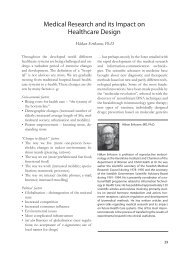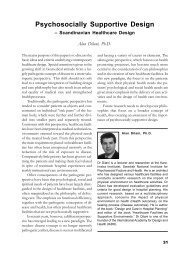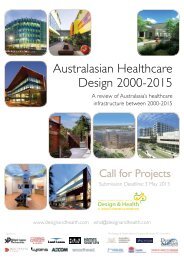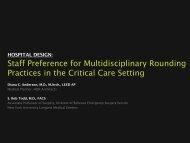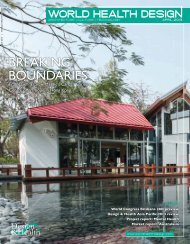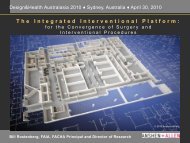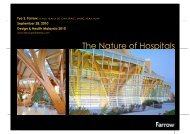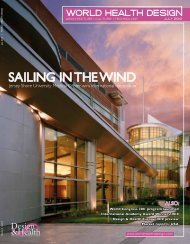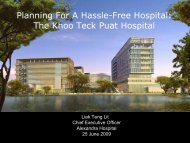SUPER GREEN - the International Academy of Design and Health
SUPER GREEN - the International Academy of Design and Health
SUPER GREEN - the International Academy of Design and Health
- No tags were found...
You also want an ePaper? Increase the reach of your titles
YUMPU automatically turns print PDFs into web optimized ePapers that Google loves.
Arts <strong>and</strong> CultureBiophilic <strong>Design</strong>:The Theory, Science <strong>and</strong> Practice <strong>of</strong> Bringing Buildings to LifeKellert S R, Heerwagen J H, Mador M LWiley Blackwell, 2008 Price: £39.99 / €50This well conceived <strong>and</strong> edited book is published at a time that requires a fundamental generationalrethink about <strong>the</strong> impact <strong>of</strong> buildings, both in terms <strong>of</strong> <strong>the</strong>ir environmental performance <strong>and</strong> <strong>the</strong>irimpact on human health <strong>and</strong> wellbeing.Paradigms are shifting, with a greater focus on <strong>the</strong> value <strong>of</strong> health <strong>and</strong> environmental capital as opposedto fi nancial wealth, calling into question current design <strong>and</strong> investment decisions, at both a micro <strong>and</strong>macro level.Long-term or short-term investment: you decide, or <strong>the</strong> markets will decide for you. Without <strong>the</strong> easyintrinsic ‘<strong>of</strong>f-plan’ growth <strong>of</strong> <strong>the</strong> last decade, clients <strong>and</strong> developers will be looking for a new language <strong>of</strong> value <strong>and</strong> performance, <strong>and</strong> differentforms <strong>of</strong> cost accounting that properly appraise <strong>the</strong> morphological <strong>and</strong> bio-diverse benefi ts <strong>of</strong> buildings that plan to reduce <strong>the</strong> running costs,maintenance <strong>and</strong> rehabilitation <strong>of</strong> our existing buildings.Biophilic design is not a mainstream phrase associated with <strong>the</strong> response <strong>and</strong> intuitive affi liation <strong>of</strong> human systems with nature. And somearchitects <strong>of</strong> certain generations (including this reviewer) raised on Erskine, Aalto, Asmussen, Cullinan, Christopher Alex<strong>and</strong>er <strong>and</strong> o<strong>the</strong>riconic European <strong>the</strong>orists <strong>and</strong> urban practitioners, all referenced here, might fi nd <strong>the</strong>mselves scratching <strong>the</strong>ir geodesic domes.They would recognise <strong>the</strong> case being made for fundamental design qualities where nature is included in <strong>the</strong> built environment, not <strong>the</strong>separateness <strong>of</strong> evidence <strong>and</strong> <strong>the</strong>ory meshed toge<strong>the</strong>r by technology – raising <strong>the</strong>ir eyes out <strong>of</strong> a ‘room with a view’ to rest on where <strong>the</strong>argument had been buried in <strong>the</strong> garden.This is <strong>the</strong> essence <strong>of</strong> <strong>the</strong> book. It is making <strong>the</strong> case for consideration, with extensive case studies, research papers with illustrations <strong>and</strong>an exposition that takes <strong>the</strong> subject way beyond abstract consideration. It is saying whatever environment you are planning, think <strong>of</strong> <strong>the</strong>seprinciples <strong>and</strong> sensibilities <strong>and</strong> if you need justifi cation for a more responsive design here it is.So leave this book on your client’s <strong>and</strong> your funder’s desk, or lift key sections out <strong>of</strong> <strong>the</strong> chaptersto green your business case. None <strong>of</strong> <strong>the</strong>se chapter authors will mind. And if you have beenfeeling left out <strong>and</strong> old-fashioned in <strong>the</strong> past few years with <strong>the</strong> triumphant pall <strong>of</strong> procurementover planning, dust down your old post-occupancy evaluations that asked <strong>the</strong> cancer patient whatwas important – <strong>the</strong> immediate outside space, <strong>the</strong> bird at <strong>the</strong> table, <strong>the</strong> door for children to playoutside when visiting. When we are ill, we need <strong>the</strong> immediacy <strong>of</strong> a supporting safe environment.Tensions with technology – yes, let <strong>the</strong> argument commence, if <strong>the</strong>y can hear you in Third Lifebehind <strong>the</strong> headphones. Get this publication a Facebook site now <strong>and</strong> plan <strong>the</strong> coolest party intown. Chapters address our neurological response to <strong>the</strong> stressors <strong>and</strong> inhibitors that are placedon our environments.It begins to inform how we become part <strong>of</strong> a building’s life cycle experience, reconnectingus to a new living architecture that can respond to intense change but without degrading coreinfrastructural elements. It is about how we might manage <strong>the</strong> end <strong>of</strong> things that previously madeour cities work <strong>and</strong> are familiar to our parents <strong>and</strong> to us.The application <strong>of</strong> <strong>the</strong> lower technologies into some <strong>of</strong> <strong>the</strong> most sophisticated buildings <strong>of</strong>our time are illustrated: <strong>the</strong> Swiss Re Tower, SkyCeilings in surgology, green ro<strong>of</strong>s over familiar citybanks, new places refl ecting aspects <strong>of</strong> scale, protective <strong>and</strong> variable. And <strong>the</strong>re are places <strong>and</strong>spaces that we might look to beyond this now.We should explore how <strong>the</strong> Finnish utilise mobile phone technologies for better access tohealthcare pr<strong>of</strong>essionals from <strong>the</strong> home. Every township has a mobile phone mast, so let us make<strong>the</strong> case for health networks free at <strong>the</strong> point <strong>of</strong> access.Mental health <strong>the</strong>rapies harnessed in a series <strong>of</strong> gardens in Stockholm, hurricane resilienceplanning <strong>and</strong> urban agriculture in Havana. As <strong>the</strong>se levels <strong>of</strong> intervention illustrate, <strong>the</strong>re is muchgood new practice out <strong>the</strong>re by inspirational individuals. And so much design complacency toattack, as this fi ne publication encourages.Phil Astley is a senior lecturer at <strong>the</strong> Medical Architecture Research Unit (MARU),London South Bank University <strong>and</strong> course director <strong>of</strong> MSc Planning Buildings for <strong>Health</strong>www.lsbu.ac.uk/maruWORLD HEALTH DESIGN | October 2008 67



